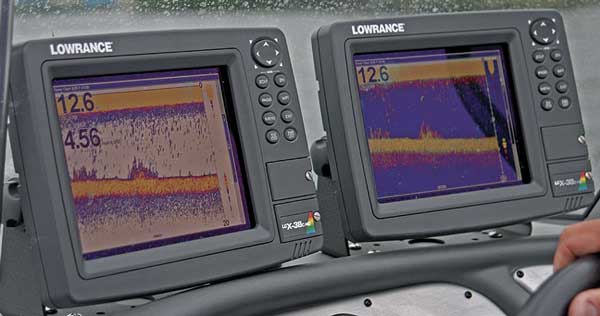
Fish finders change their appearance and add new features each year, but the principles of sonar haven’t changed since World War II. A simple sonar system consists of a control head with a display and controls, a transducer and a power source.
Greatly simplified, a single bottom sounding goes like this: The control head tells the transmitter to send a burst of electrical energy down a cable to the transducer. The transducer, acting like the earpiece of a telephone, converts the electrical energy into acoustic energy and broadcasts a sound pulse that spreads out in roughly a cone-shaped pattern as it travels toward the bottom.
The sound hits the bottom, and echoes bounce back to the transducer, which then acts like a telephone mouthpiece and converts the sound back into electrical energy. The electrical signal travels back up the cable to the head unit.
The “main brain” in the control head is programmed with the speed of sound through water and equipped with an accurate electronic timer so it simply measures the time it takes for a signal to travel to the bottom and return, computes that elapsed time into distance and displays the distance as depth.
The bottom isn’t the only thing that returns echoes, of course. They also bounce back from suspended objects like fish and from bottom structure and cover, but their distance from the transducer is measured the same way.
It is worth noting that an object’s distance from the transducer is not always its true depth, that distance only equals depth when the object is directly below a transducer that is aimed straight down. A fish out toward the edge of a transducer’s beam might be, say, 25 feet (diagonally) from the transducer but only 20 feet below the water’s surface and that can make a difference when you try to drop a lure in front of it.
You’ve probably heard the term “operating frequency” applied to fish finders. It is the frequency at which the active element in a transducer vibrates when energized by the head unit. It broadcasts sound into the water at this frequency, and then listens only for echoes returning at this frequency.
With the help of some mind-numbing math, a unit’s software helps its digital brain concentrate on hearing only sound at this operating frequency while ignoring all the other noise in the underwater environment.
Traditionally, the size, thickness and shape of the man-made crystal in a transducer pretty much controlled its frequency and cone angle, but some of today’s multi-frequency units are sophisticated enough to coax more than one frequency and massage different cone angles out of a single crystal or group of crystals.
Fish finders do more with less these days in terms of transmitter power, too. New digital units like Lowrance’s Broadband Sounder One put out only 31 watts (RMS), but the company says it delivers performance equal to that of an analog unit with 3,750 watts (RMS) and can reach depths down to 5,000 feet!
I found I needed only a fraction of the sensitivity I normally use when testing this unit at typical fishing depths.
Another good example is Humminbird’s Side Imaging sonar. Probably 90 percent of the sound broadcast horizontally off to the sides of a boat “bank shots” away from the transducer, giving returning echoes only about 10 percent of the sound power common to vertical soundings, yet the sometimes incredible screen readings often look like only slightly blurry black-and-white photographs of the bottom and structure.
No matter how amazing fish-finder performance gets, don’t be confused by all the high-tech hyperbole. The basic principles of sonar remain as simple as combining a telephone with a stopwatch.


